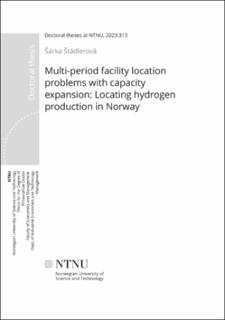| dc.contributor.advisor | Schütz, Peter | |
| dc.contributor.advisor | Tomasgard, Asgeir | |
| dc.contributor.author | Štádlerová, Šárka | |
| dc.date.accessioned | 2023-10-17T09:10:15Z | |
| dc.date.available | 2023-10-17T09:10:15Z | |
| dc.date.issued | 2023 | |
| dc.identifier.isbn | 978-82-326-7325-4 | |
| dc.identifier.issn | 2703-8084 | |
| dc.identifier.uri | https://hdl.handle.net/11250/3096916 | |
| dc.description.abstract | According to the Paris Agreement on climate change, CO2 emissions must be decreased by 40% towards 2030. Decarbonization of the transportation sector is a crucial step to meet the emission reduction targets in the Paris Agreement. Hydrogen is considered a promising low-emission fuel alternative in the transportation sector. However, low experience with hydrogen and limited availability are the main challenges when introducing hydrogen as a low-emission fuel in the transportation sector. Hence, designing the hydrogen production infrastructure and providing a reliable hydrogen supply is essential to encourage potential customers to switch from fossil fuels to hydrogen.
This thesis formulates optimization models and develops efficient solution methods to solve the problem of designing hydrogen production infrastructure in Norway. The papers in this thesis contribute to the state-of-the-art on deterministic and stochastic multi-period facility location problems with capacity expansion. To accurately represent the costs of hydrogen production, we consider specific aspects of hydrogen production technologies in our mathematical models. These aspects include economies of scale in investment, capacity-dependent short-term production costs, and considerations of minimum production requirements. Further, we present solution methods for deterministic as well as stochastic formulations based on Lagrangian relaxation. Furthermore, we provide managerial insight into the cost analysis of hydrogen production in Norway.
This thesis consists of four research papers. In Paper I, we formulate and solve the problem of locating hydrogen production facilities in Norway considering deterministic demand. In Paper II, we present a solution method based on Lagrangian relaxation for the problem introduced in Paper I. In the last two papers, future demand is considered an uncertain parameter. In Paper III, we use sample average approximation to solve the problem, while in Paper IV, a solution method based on Lagrangian relaxation is developed. | en_US |
| dc.language.iso | eng | en_US |
| dc.publisher | NTNU | en_US |
| dc.relation.ispartofseries | Doctoral theses at NTNU;2023:313 | |
| dc.relation.haspart | Paper 1: Stadlerova, Sarka; Schütz, Peter. Designing the Hydrogen Supply Chain for Maritime transportation in Norway. Lecture Notes in Computer Science (LNCS) 2021 ;Volume 13004. s. 36-50. Copyright © 2021 Springer Nature Switzerland AG. | en_US |
| dc.relation.haspart | Paper 2: Štádlerová, Šárka; Schütz, Peter; Tomasgard, Asgeir. Multi-period facility location and capacity expansion with modular capacities and convex short-term costs. This paper is submitted for publication and is therefore not included. | en_US |
| dc.relation.haspart | Paper 3: Stadlerova, Sarka; Aglen, Trygve Magnus; Hofstad, Andreas; Schütz, Peter. Locating Hydrogen Production in Norway Under Uncertainty. Lecture Notes in Computer Science (LNCS) 2022 ;Volume 13557. s. 306-321. Copyright © 2022 The Author(s), under exclusive license to Springer Nature Switzerland AG | en_US |
| dc.relation.haspart | Paper 4: Stadlerova, Sarka; Jena, Sanjay Dominik; Schütz, Peter. Using Lagrangian relaxation to locate hydrogen production facilities under uncertain demand: a case study from Norway. Computational Management Science 2023 ;Volum 20.(1). Open Access This article is licensed under a Creative Commons Attribution 4.0 International License CC-BY. | en_US |
| dc.title | Multi-period facility location problems with capacity expansion: Locating hydrogen production in Norway | en_US |
| dc.type | Doctoral thesis | en_US |
| dc.subject.nsi | VDP::Samfunnsvitenskap: 200::Økonomi: 210 | en_US |

